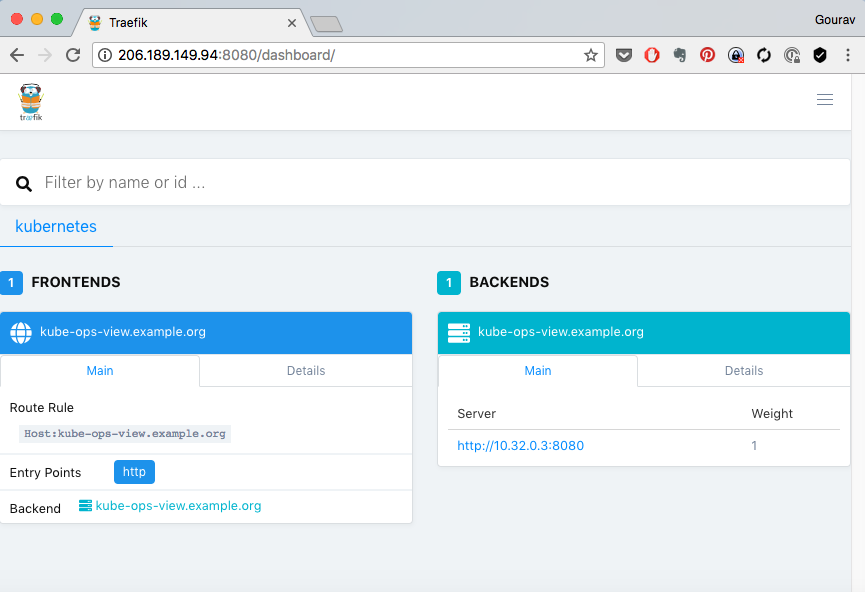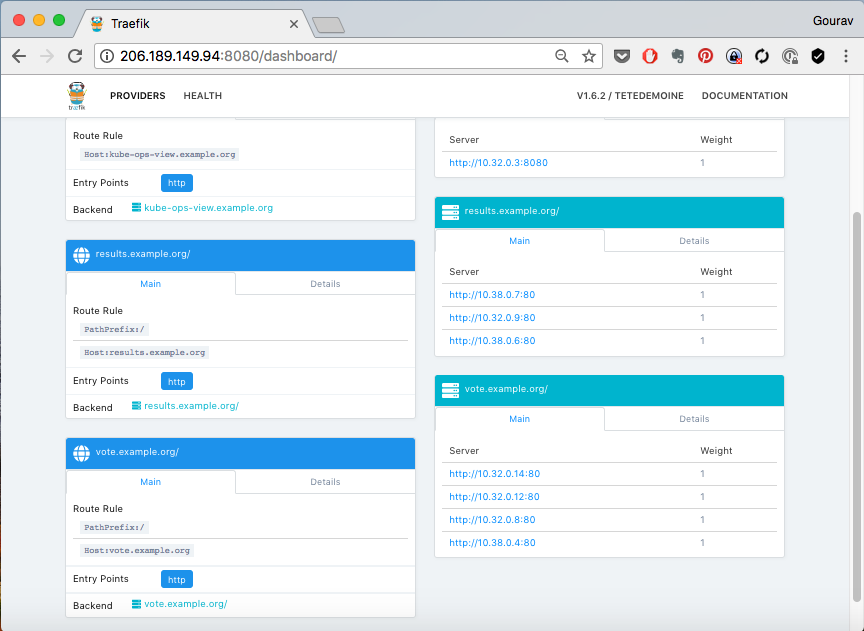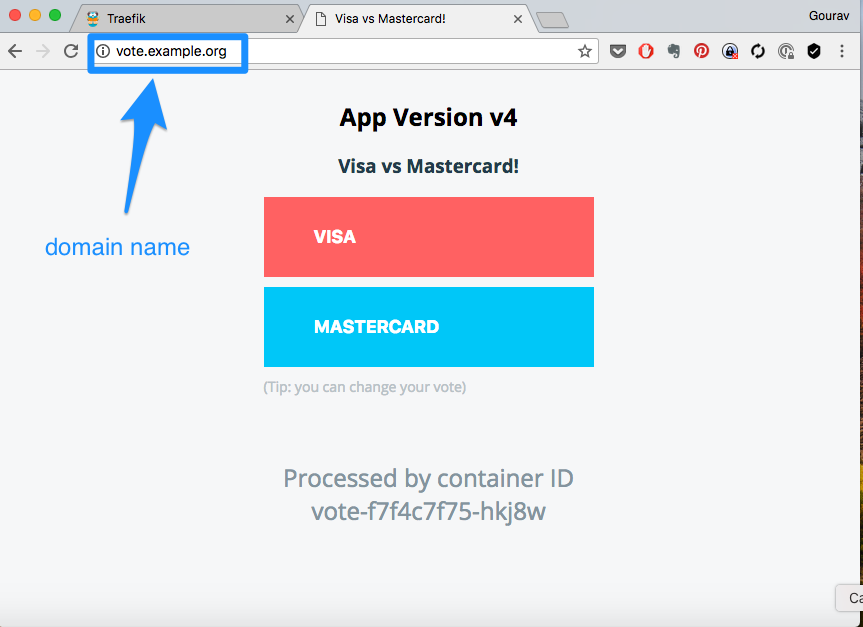Lab K201 - Application Routing with Ingress Controllers
Pre Requisites
- Ingress controller such as Nginx, Trafeik needs to be deployed before creating ingress resources.
- On GCE, ingress controller runs on the master. On all other installations, it needs to be deployed, either as a deployment, or a daemonset. In addition, a service needs to be created for ingress.
- Daemonset will run ingress on each node. Deployment will just create a highly available setup, which can then be exposed on specific nodes using ExternalIPs configuration in the service.
Launch Ingress Controller
An ingress controller needs to be created in order to serve the ingress requests. As part of this lab you are going to use Traefik as the ingress controller. Its a fast and lightweight ingress controller and also comes with great documentation and support.
+----+----+--+
| ingress |
| controller |
+----+-------+
You are going to setup ingress controller using helm. Assuming helm is already installed, begin adding the repository to install traefik as a ingress controller from:
helm repo add traefik https://helm.traefik.io/traefik
helm repo update
Pull Traffic Chart
helm pull --untar traefik/traefik
cd traefik
Create a new file my.values.yaml with the following contents
ports:
traefik:
port: 9000
expose: true
exposedPort: 9000
nodePort: 30300
protocol: TCP
web:
port: 8000
expose: true
exposedPort: 80
nodePort: 30400
protocol: TCP
service:
enabled: true
single: true
type: NodePort
Source : traefik deployment customization spec · GitHub
Apply with the custom values file created as above,
kubectl create ns traefik
helm install traefik --namespace=traefik --values=my.values.yaml .
Validate
helm list -A
kubectl get all -n traefik
Use the following URIs to access Traefik and Traefik Dashboard ,
- Traefik Web : http://xx.xx.xx.xx:30400 (you may see 404 page not found error, which is okay and expected here).
- Traefik Dashboard : http://xx.xx.xx.xx:30300/dashboard/ (training slash “/“ is a must) (you are expected to a nice looking see Traefik dashboard here).
replace xx.xx.xx.xx with the external IP used earlier

Set up Named Based Routing for Vote App
We will direct all our request to the ingress controller now, but with differnt hostname e.g. vote.example.com or results.example.com. And it should direct to the correct service based on the host name.
In order to achieve this you, as a user would create a ingress object with a set of rules,
+----+----+--+
| ingress |
| controller |
+----+-------+
| +-----+----+
+---watch----> | ingress | <------- user
+----------+
file: vote-ing.yaml
---
apiVersion: networking.k8s.io/v1
kind: Ingress
metadata:
name: vote
namespace: instavote
annotations:
kubernetes.io/ingress.class: traefik
traefik.ingress.kubernetes.io/rule-type: PathPrefixStrip
spec:
rules:
- host: vote.example.com
http:
paths:
- path: /
pathType: Prefix
backend:
service:
name: vote
port:
number: 80
And apply
kubectl get ing
kubectl apply -f vote-ing.yaml --dry-run
kubectl apply -f vote-ing.yaml
Since the ingress controller is constantly monitoring for the ingress objects, the moment it detects, it connects with traefik and creates a rule as follows.
+----------+
+--create----> | traefik |
| | rules |
| +----------+
+----+----+--+ ^
| ingress | :
| controller | :
+----+-------+ :
| +-----+----+
+---watch----> | ingress | <------- user
+----------+
where,
- A user creates a ingress object with the rules. This could be a named based or a path based routing.
- An ingress controller, in this example traefik constantly monitors for ingress objects. The moment it detects one, it creates a rule and adds it to the traefik load balancer. This rule maps to the ingress specs.
You could now see the rule added to ingress controller,

Where,
-
vote.example.com is added as frontend. This frontends point to service vote.
-
respective backend also appear on the right hand side of the screen, mapping to each of the service.
Add Local DNS
You have created the ingress rules based on hostnames e.g. vote.example.com and results.example.com. In order for you to be able to access those, there has to be a dns entry pointing to your nodes, which are running traefik.
vote.example.com -------+ +----- vote:81
| +-------------+ |
| | ingress | |
+===> | node:80 | ===+
| +-------------+ |
| |
results.example.com -------+ +----- results:82
To achieve this you need to either,
- Create a DNS entry, provided you own the domain and have access to the dns management console.
- Create a local hosts file entry. On unix systems its in
/etc/hostsfile. On windows its atC:\Windows\System32\drivers\etc\hosts. You need admin access to edit this file.
For example, on a linux or osx, you could edit it as,
sudo vim /etc/hosts
And add an entry such as ,
xxx.xxx.xxx.xxx vote.example.com results.example.com kube-ops-view.example.org
where,
- xxx.xxx.xxx.xxx is the actual IP address of one of the nodes running traefik.
And then access the app urls using http://vote.example.com or http://results.example.com

Add another Web Application with Ingress
kubectl create deployment nginx --image=nginx
kubectl create service clusterip nginx --tcp=80
Add ingress rule
file: web-ing.yaml
---
apiVersion: networking.k8s.io/v1
kind: Ingress
metadata:
name: web
namespace: instavote
annotations:
kubernetes.io/ingress.class: traefik
traefik.ingress.kubernetes.io/rule-type: PathPrefixStrip
spec:
rules:
- host: web.example.com
http:
paths:
- path: /
pathType: Prefix
backend:
service:
name: nginx
port:
number: 80
Source: Ingress for Web App · GitHub
And update hosts file with new route as ,
xxx.xxx.xxx.xxx vote.example.com web.example.com results.example.com kube-ops-view.example.org
Visit http://web.example.com:30400 to see your request being routed to nginx web page.
Mini Project : Configure Ingress for Result App
Now that you have added the ingress rule for the vote app, follow the same method and add one for the result app as well which is running in the same namespace.
The final validation would be, when you access or http://result.example.com you should see it pointing to the result app.
Reading Resources
References
Keywords
- trafeik on kubernetes
- kubernetes ingress
- kubernetes annotations
- daemonsets